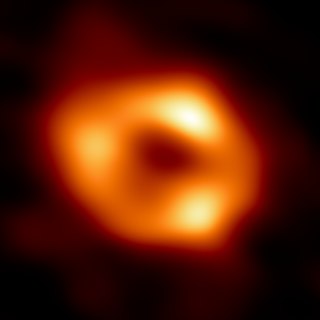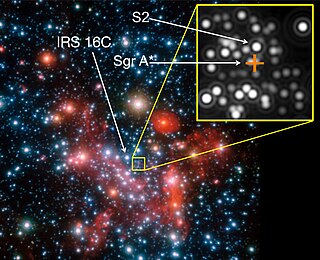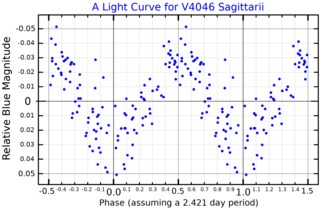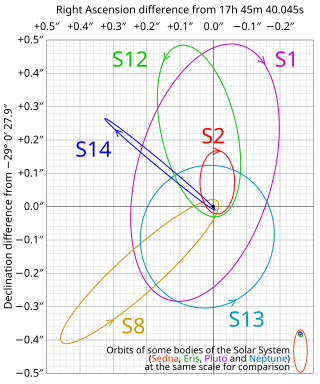Related Research Articles
The Schwarzschild radius or the gravitational radius is a physical parameter in the Schwarzschild solution to Einstein's field equations that corresponds to the radius defining the event horizon of a Schwarzschild black hole. It is a characteristic radius associated with any quantity of mass. The Schwarzschild radius was named after the German astronomer Karl Schwarzschild, who calculated this exact solution for the theory of general relativity in 1916.

A supermassive black hole is the largest type of black hole, with its mass being on the order of hundreds of thousands, or millions to billions, of times the mass of the Sun (M☉). Black holes are a class of astronomical objects that have undergone gravitational collapse, leaving behind spheroidal regions of space from which nothing can escape, not even light. Observational evidence indicates that almost every large galaxy has a supermassive black hole at its center. For example, the Milky Way galaxy has a supermassive black hole at its center, corresponding to the radio source Sagittarius A*. Accretion of interstellar gas onto supermassive black holes is the process responsible for powering active galactic nuclei (AGNs) and quasars.

A stellar black hole is a black hole formed by the gravitational collapse of a star. They have masses ranging from about 5 to several tens of solar masses. They are the remnants of supernova explosions, which may be observed as a type of gamma ray burst. These black holes are also referred to as collapsars.

Sagittarius A*, abbreviated Sgr A*, is the supermassive black hole at the Galactic Center of the Milky Way. Viewed from Earth, it is located near the border of the constellations Sagittarius and Scorpius, about 5.6° south of the ecliptic, visually close to the Butterfly Cluster (M6) and Lambda Scorpii.

S2, also known as S0–2, is a star in the star cluster close to the supermassive black hole Sagittarius A* (Sgr A*), orbiting it with a period of 16.0518 years, a semi-major axis of about 970 au, and a pericenter distance of 17 light hours – an orbit with a period only about 30% longer than that of Jupiter around the Sun, but coming no closer than about four times the distance of Neptune from the Sun. The mass when the star first formed is estimated by the European Southern Observatory (ESO) to have been approximately 14 M☉. Based on its spectral type, it probably has a mass of 10 to 15 solar masses.

Markarian 231 is a Type-1 Seyfert galaxy that was discovered in 1969 as part of a search of galaxies with strong ultraviolet radiation. It contains the nearest known quasar. Markarian 231 is located about 581 million light years away from Earth, in the constellation of Ursa Major.

V4046 Sagittarii is a young binary consisting of two K-type main-sequence stars. The two stars are about 271 light-years away from the Earth. The two stars orbit each other every 2.42 days on a circular orbit.

Y Sagittarii is a variable star in the constellation of Sagittarius. It is a Cepheid variable with an apparent magnitude that ranges around +5.77. The measure of its parallax by Hubble Space Telescope puts Y Sagittarii to 1,293 light-years away from the Solar System.
S55 is a star that is located very close to the centre of the Milky Way, near the radio source Sagittarius A*, orbiting it with an orbital period of 12.8 years. Until 2019, when the star S62 became the new record holder, it was the star with the shortest known period orbiting the black hole at the centre of the Milky Way. This beat the record of 16 years previously set by S2. The star was identified by a University of California, Los Angeles team headed by Andrea M. Ghez. At its periapsis, its speed reaches 1.7% of the speed of light. At that point it is 246 astronomical units from the centre, while the black hole radius is only a small fraction of that size. It passed that point in 2009 and will be there again in 2022.
(394130) 2006 HY51 is a near-Earth object of the Apollo asteroid group with a high orbital eccentricity, approximately 1.2 kilometers in diameter. It was discovered on 26 April 2006, by LINEAR at Lincoln Lab's ETS in Socorro, New Mexico, United States.
A tidal disruption event (TDE) is an astronomical phenomenon that occurs when a star approaches sufficiently close to a supermassive black hole (SMBH) to be pulled apart by the black hole's tidal force, experiencing spaghettification. A portion of the star's mass can be captured into an accretion disk around the black hole, resulting in a temporary flare of electromagnetic radiation as matter in the disk is consumed by the black hole. According to early papers, tidal disruption events should be an inevitable consequence of massive black holes' activity hidden in galaxy nuclei, whereas later theorists concluded that the resulting explosion or flare of radiation from the accretion of the stellar debris could be a unique signpost for the presence of a dormant black hole in the center of a normal galaxy. Sometimes a star can survive the encounter with an SMBH, and a remnant is formed. These events are termed partial TDEs.

ESO 444-46 is a class E4 supergiant elliptical galaxy; the dominant and brightest member of the Abell 3558 galaxy cluster around 640 million light-years away in the constellation Centaurus. It lies within the core of the massive Shapley Supercluster, one of the closest neighboring superclusters. It is one of the largest galaxies in the local universe, and possibly contains one of the most massive black holes known. The black hole's mass is very uncertain, with estimates ranging from as low as 501 million M☉, to as high as 77.6 billion M☉.
The small planet radius gap is an observed scarcity of planets with radii between 1.5 and 2 times Earth's radius, likely due to photoevaporation-driven mass loss. A bimodality in the Kepler exoplanet population was first observed in 2011 and attributed to the absence of significant gas atmospheres on close-in, low-mass planets. This feature was noted as possibly confirming an emerging hypothesis that photoevaporation could drive atmospheric mass loss This would lead to a population of bare, rocky cores with smaller radii at small separations from their parent stars, and planets with thick hydrogen- and helium-dominated envelopes with larger radii at larger separations. The bimodality in the distribution was confirmed with higher-precision data in the California-Kepler Survey in 2017, which was shown to match the predictions of the photoevaporative mass-loss hypothesis later that year.

CI Tauri is a young star, about 2 million years old, located approximately 500 light years away in the constellation Taurus. It is still accreting material from a debris disk at an unsteady pace, possibly modulated by the eccentric orbital motion of the inner planet. The spectral signatures of compounds of sulfur were detected from the disk.

TOI-700 d is a near-Earth-sized exoplanet, likely rocky, orbiting within the habitable zone of the red dwarf TOI-700, the outermost planet within the system. It is located roughly 101.4 light-years (31.1 pc) away from Earth in the constellation of Dorado. The exoplanet is the first Earth-sized exoplanet in the habitable zone discovered by the Transiting Exoplanet Survey Satellite (TESS).
HD 164509 is a binary star system in the constellation of Ophiuchus. The primary component has an orbiting exoplanet companion. This system is located at a distance of 175 light years based on parallax measurements, and is drifting further away with a radial velocity of 13.7 km/s. It has an absolute magnitude of 4.64, but at that distance the system has an apparent visual magnitude of 8.10, which is too faint to be seen with the naked eye.
In astronomy, quenching is a process in which a galaxy loses cold gas, thus strongly suppressing star formation, because stars are formed from Nebulae and Nebulae are formed from accumulated Interstellar gas in the Interstellar medium (ISM). Evidence suggests that active supermassive black holes drive the process. One common evolutionary path on the galaxy color–magnitude diagram may start with a blue spiral galaxy with much star formation. The black hole at its center may start growing rapidly, and somehow start quenching the galaxy, which relatively quickly transitions through the "green valley", ending up more red.

The Sagittarius A* cluster is the cluster of stars in close orbit around Sagittarius A*, the supermassive black hole at the center of the Milky Way. The individual stars are often listed as "S-stars", but their names and IDs are not formalized, and stars can have different numbers in different catalogues.
S4716 is an S star located at the center of the Milky Way galaxy orbiting the supermassive blackhole Sgr A* at the speed of 8,000 kilometres per second in closest approach of 100 AU. As of July 2022, the orbital period of S4716 was the shortest known of any star in the Milky Way galaxy. It orbits the Sgr A* in 4.0 years, on an elliptical orbit with an eccentricity of 0.75. Its closest approach to Sgr A* is 15 billion kilometers, while its farthest approach is 100 billion kilometers. The star can be detected by NIRC2 (Keck), OSIRIS (Keck), SINFONI (VLT), NACO (VLT) and GRAVITY (VLT).
References
- 1 2 "Sgr A*". SIMBAD . Centre de données astronomiques de Strasbourg . Retrieved 2021-08-23.
- 1 2 Peißker, Florian; Eckart, Andreas; Zajaček, Michal; Ali, Basel; Parsa, Marzieh (2020). "S62 and S4711: Indications of a Population of Faint Fast-moving Stars inside the S2 Orbit. S4711 on a 7.6 yr Orbit around Sgr A*". The Astrophysical Journal. 899 (1): 50. arXiv: 2008.04764 . Bibcode:2020ApJ...899...50P. doi: 10.3847/1538-4357/ab9c1c . S2CID 221095771.
- 1 2 3 4 Peissker, Florian; Eckart, Andreas; Parsa, Marzieh (January 2020). "S62 on a 9.9 year orbit around SgrA*". The Astrophysical Journal . 889 (1): 61. arXiv: 2002.02341 . Bibcode:2020ApJ...889...61P. doi: 10.3847/1538-4357/ab5afd . S2CID 211043784.